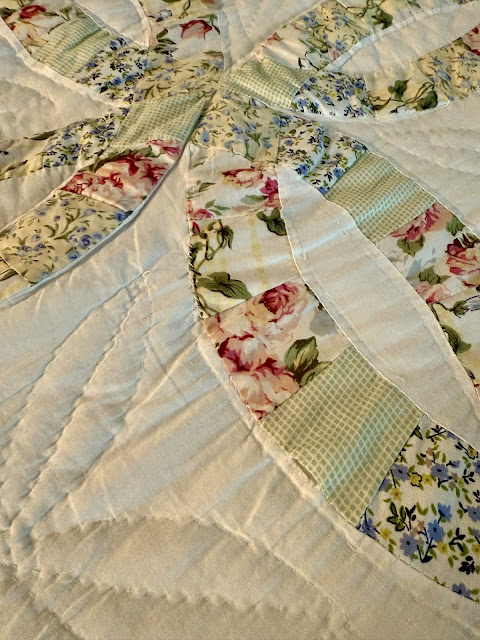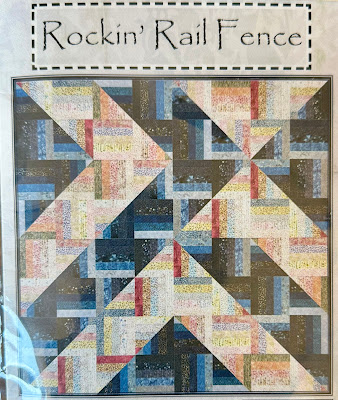I am not writing about trying to recover from an addiction to quilting, but about restoring, rehabilitating, salvaging, or even simply repairing old quilts. I have spent a third of my life sleeping under cotton quilts. Most of them have been made by my grandmother, or obtained, often through circuitous routes, by my mother. My mother didn't quilt, but she had fond memories of her mother quilting. She valued quilts, she wanted them, she just didn't want to pay for them. I may have been influenced by her attitude, especially since I want to have a quilt or two available to me when I get sleepy.
That's easy to do, now that quilts abound for sale on line. The world market (no not that one, the generic one) has responded to the demand for quilts. They are, and I assume, have been available for quite some time at reasonable prices. My problem is that I favor the quilts I grew up sleeping under--cotton, hand quilted, cotton filled (sometimes with cotton seeds still in them here and there). Thus, with my preferences for pure cotton handmade quilts and my heritage of not paying for them (or at least not much), I have a couple of quilts that I am beginning to wear out. They weren't much to begin with so I justify rehabbing them.
Meanwhile, I am learning to make quilts. So far, I have learned that it is ferociously expensive to make a quilt if it involves purchasing the materials and assembling a quilt from them. Not that I have a problem with the cost. If it results in a wonderful quilt that will last for years, why not? If it is enjoyable to select fabrics, why not? However, there is a lot of sewing and handwork along that route. Some of it can be hired, yes, all of it if you are willing to spend....that's right, I have that heritage to deal with. Either I pay a fair price to a local quilter for a high quality handmade cotton quilt or I make it myself for maybe half the price. However, my skills are not up to the level I would get if I purchased one.
That's why I decided to improve my skills by rehabbing two old quilts. I bought them both at our local second hand sale. The first one, purchased about seven years ago, was ripping at the seams between the smallest pieces. Although I only paid $10 for it, this was not an imitation printed quilt look-alike. It is machine pieced, with the smallest pieces a little over 2" square. Even though this is not a printed patchwork fabric, it is definitely not an american made quilt. I found a tag on it clearly labeling it as imported. The tag was the standard commercial tag that's found on bedding. It is hand quilted, but not heavily. Where the seams are not quilted down to the backing, they have split open. The exposed seam allowances are fraying.
I sewed these frayed edges closed, whip stitching together the two edges together about 1/8" back from the frayed edge. The fabric is loose enough to allow it to still fit together without too much stretching or stress on the new seam. Although a ladder stitch would be less visible, I am more concerned with durability than with looks on this old quilt.
Actually, the hand quilting, as sparse as it is and as large as the stitches are, is still smaller and more precise than I can currently manage. It's quite daunting to imagine who might have quilted this in whatever country it was made in. I hope I can quilt it as well. With the end goal of improving my hand quilting and machine quilting chops, I have hand quilted the smaller pieces in the center of the quilt. Prior to this, I machine quilted the small pieces around the edges, since they are easier to reach on a standard sewing machine.
My whip stitched repairs are at the top of the foremost white square and at the bottom of the white square on the top right of this photo. I have hand quilted the squares in the middle, finishing all of them after taking this photo, working up one side of the squares, turning the quilt, and completing the other side. That method allowed me to continue from square to square without cutting my thread.
Supposedly, the quilting will hold the layers of the quilt together and prevent the seams from ripping apart. Admittedly, the seams are ripping open because I am machine washing the quilt a couple of times a year. I don't intend to stop doing that. This quilt was on my bed for about 6 months every year. I enjoyed it, even though it didn't quite match my room colors and it was to me, a bit garish. Now that the colors have faded, it looks a little better. More quilting should improve the looks as well as the durability. Also, as I continue washing it, I will see if it holds together better. If not, I will then assume that quilts need to be hand washed. The prospect of hand washing a queen size quilt is really going to dampen my enthusiasm for making my own quilts.
With my disappointment in this old quilt weighing on my mind, I went second hand quilt shopping again. The replacement has turned out to be a real score. One of my mother's quilts was, I thought for years, I wedding ring quilt. She won it in a raffle for $1. It's a beautiful quilt made in the 1980's by a local church group, but it is not a wedding ring quilt. It is a Dresden plate. Both are circular designs, something I would never attempt at this stage. However, once my quilting knowledge grew to the point that I could correctly identify the Dresden plate design, I became more disappointed. I didn't have a wedding ring quilt.
But now I do, for $5. Not only that, it is the right shade of green to coordinate with my bedroom.
I was quite baffled as to why this quilt, which is king size, would be priced so low. The first quilt was in pretty good shape when I purchased it for $10. This second one looked nice, but once it was spread out, the split seams became apparent. It is fairly adequately quilted. I think it is just an old quilt that was made with thin cotton fabrics. I set to work right away sewing up the rips. This time I used ladder stitch so the repairs don't show as much as my repairs in the first quilt.
I say that, but now I see a whip stitch repair in the second photo. There's also a rip in the photo that I didn't see when I was repairing it. I'm sure there's more. I had better get to work on the replacement before this one wears out.
As a final note, in case you are reading this to learn about repairing old quilts, I have repaired a truly vintage quilt. This one was a bow tie quilt that was quilted around 1950. It had a couple of bites taken out of it all the way to the backing. I suspect rat or maybe boisterous kid damage. I gave it a gentle wash in the bulky cycle of my machine, hung it out to dry, and repaired the two holes by appliqueing a piece of coordinating fabric over them, first fluffing up the remaining batting to fill the hole. I actually used a bit of an old sheet. It was the right color and had the same faded and worn appearance as the rest of the quilt. The descendant of the quilter was thrilled to receive it and couldn't even find the areas I repaired. I am sorry I didn't take a photo of that one.






